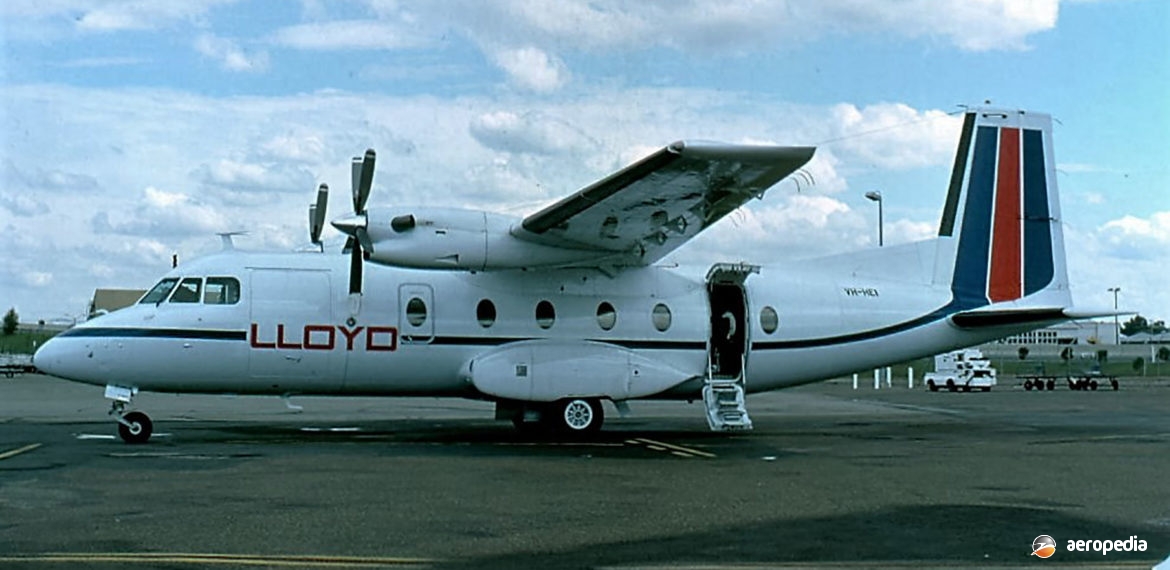Photograph:
Aerospatiale 298 Mohawk of Lloyd Aviation VH-HEI (c/n 99) at Eagle Farm, QLD (Michael Madden)
Country of origin:
France
Description:
Commercial commuter airliner
Power Plant:
Two 880 kw (1,180 shp) Pratt & Whitney Canada PT6A-45 turboprops
Specifications:
- Wingspan: 21.9 m (71 ft 10 ¼ in)
- Length: 19.28 m (63 ft 3 in)
- Height: 6.2 m (20 ft 4 in)
- Wing area: 55 m² (592.03 sq ft)
- Max speed: 385 km/h (239 mph)
- Cruising speed: 375 km/h (233 mph)
- Service ceiling: 7,160 m (23,500 ft)
- Initial rate of climb: 354 m/min (1,160 ft/min)
- Range with 26 passengers no reserves: 1,392 km (865 miles)
- Range with max fuel no reserves: 2,132 km (1,325 miles)
- Empty weight: 7,030 kg (15,498 lb)
- Loaded weight: 10,600 kg (23,369 lb)
History:
The Nord 262 light transport, originally known as the Max Holste Super Broussard, was designed by Avions Max Holste but in 1960 this company was taken over by Nord Aviation. The prototype of the series, known as the MH 260, was first flown on 29 July 1960. Nord then took over responsibility for development, production, and sale of the type. Some re-design took place to produce the Nord 262, this having a pressurised fuselage of circular cross-section and up-rated engines.
The prototype of the model 262 first flew on 24 December 1962. Production of four variants then proceeded. The first series becoming known as the 262A; followed by the 262B for Air Inter (of which only four were built); the 262C, named Fregate, with more powerful engines and an increased wingspan; and the 262D Fregate. Total production of the series was 72 262As and 262Bs, and 33 Fregates, the largest user being the French Air Force with 24. A merger of Nord and Sud Aviation then occurred and the new company became known as Aerospatiale. The series was then commonly referred to as the Aerospatiale 262.
In 1977 Mohawk Air Services in the United States converted a number to Model 298 standard by the installation of Pratt & Whitney PT6A-45 turboprops driving five-blade propellers, new avionics, an APU, and seven wing modifications. The first aircraft so modified flew for the first time on 7 January 1975. In all nine were modified to Model 298 standard, the last few having the modifications performed by Frakes Aviation in 1978.
In early 1987 Lloyd Aviation of Adelaide, SA, purchased four examples of the 28 seat Mohawk 298, as they became known, from Ransome Airlines in the United States to replace EMB Bandeirantes on its South Australian routes. They first entered service in July 1987. In 1989 Par Avion, a Tasmanian operator, announced it was obtaining the Mohawks for its Launceston – Essendon service, operating VH-HEI, VH-HIX and VH-HKS at various periods in 1989 and 1990 on lease. At another stage they were operated by Ansett Express for short periods in 1991 and 1992. At one stage the type operated in New South Wales on the Sydney – Dubbo route, later seeing service with Queensland Pacific Airlines.
After retirement in the early 19902 all four were obtained by Majestic Airways as a spares source. These four aircraft were: VH-HEI (c/n 99 – ex N29814); VH-HIX (c/n 42 – ex N29811, N26228, F-BPNY, F-WOFD); VH-HKS (c/n 017 – ex N2611) and VH-HKT (c/n 050 – ex N29817, TS-LIP, F-OCNQ, F-WOFC). They were to be scrapped but in the event one was preserved to be placed on a pole at Bundaberg airport in Queensland but this did not occur. One has been restored and has been placed on display at the Queensland Air Museum at Caloundra. The other two were sunk at sea to become habitats for marine life.

